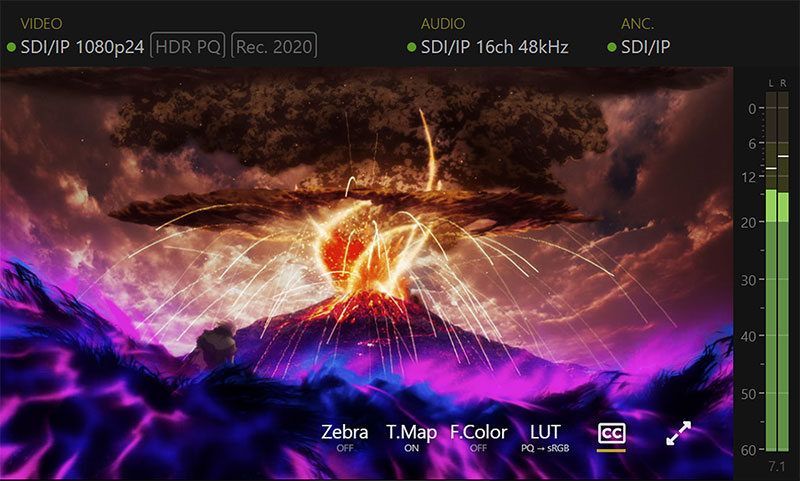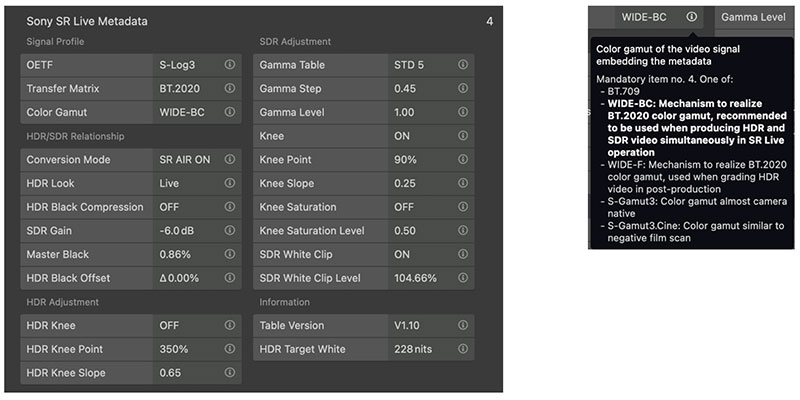The LVB440 IP Analyzer's IP traffic and signal monitoring resources are now supplemented with signal generation tools plus the ability to monitor and analyse Sony’s SR Live Metadata.

LVB440 HDR display
Leader Electronics LVB440 IP Analyzer's IP traffic and signal monitoring resources are now supplemented with signal generation tools plus the ability to monitor and analyse Sony’s SR Live Metadata. Earlier on, at the end of 2021, the device gained support for JPEG XS ST 2110-22 compression analysis, closed captioning measurement, 7.1 and 5.1 surround sound, and loop-mode continuous capture of data packets.
The new signal generation and SR Live Metadata tools make the LVB440 especially efficient when evaluating network performance. Operators can create placeholder reference signals either locally, using the integrated GUI, or remotely via NMOS. SDR and HDR signals such as chroma bars can be configured for specific video resolutions or refresh rates, including a user-definable video or audio ident, saving time during system setup or alteration.
Placeholders can also be created to represent video and audio feeds that will be required later in the production timeline. In this way, network connections such as remote OB or studio sources can be tested before the start of a live transmission.
Sony’s SR Live Workflow and Metadata
Leader added support for SR Live Metadata decoding and display to its ZEN series waveform monitors and rasterizers in 2019 and is now extending this capability to the LVB440 for use in IP network evaluation. SR Live for HDR forms part of the broadcast production workflow when content is transcoded from 4K HDR or HD HDR. Using metadata sourced from each camera, the LVB440 enables production staff to identify and correct potential issues quickly and effectively.

Sony originally developed the SR Live workflow in 2016 in order to reduce the costs and complexity of simultaneous live HDR and SDR programme production by a single crew. With SR standing for ‘Super-Reality’ or ‘Scene Referred’ Live production, the workflow preserves image quality and supports flexible multipurpose distribution format options ranging from HD SDR up to 4K HDR (PQ/SMPTE ST.2084 and HLG).
The SR Live Metadata packet stores 26 parameters required for mutual conversion of HDR / SDR content in the Sony SR Live for HDR workflow. This metadata can be embedded in SDI signals, MXF files and IP networks and, in combination with compatible products, helps prevent errors when setting up conversion, thereby simplifying operations.
The 26 parameters describe creative decisions and camera adjustments that camera operators make during production. Embedding them in the SDI signal allows exact duplication of the SDR programme from the HDR layer, and remains available even if the HDR-to-SDR conversion takes place later on during production at the broadcast station. The parameters can also be checked visually, both live and during post.

Support for JPEG XS ST 2110-22 compression analysis
Multiple Format Analysis over Networks
The LVB440 is a 1U device that analyses SD, HD, HD HDR, 4K and 4K HDR data flow over media networks of any size. Designed to monitor and analyse high-bitrate media traffic in broadcast production studios, OB vehicles, master control facilities and transmission networks, the analyser supports data rates of 10, 25, 40 and 50 gigabit/s, extending up to 100 gigabit/s via dual interfaces. The core processor is more than capable of handling the 48 gigabit/s data rate required for full bandwidth source 8K.
The LVB440 is controlled via an HTML-5 browser and supports up to eight local or remote users. It gives production teams, for example, the ability to perform real-time checks on large numbers of streams and multiple resolutions in parallel at multiple locations. Operators can survey every media transport layer of an IP network simultaneously, allowing issues to be rectified before they impact the quality of service that program viewers experience.
When connected to primary and secondary networks, the LVB440 can monitor and analyse redundancy within the SMTPE ST 2022-7 standard, which is used to ensure seamless protection switching. Tools are supplied for PTP clock analysis, including clock source detection, timing accuracy and individual flow path-latency. SMPTE ST 2110, ST 2022-6 and ST 2059-2 PTP standards as well as Networked Media Open Specifications (NMOS) are also supported.

Compact 1U housing.
Ease of Use
Intuitive packet display analytics including single or multiple stream correlation make errors faster and easier to identify. Media metadata and deep packet analytics can be displayed. Traditional colorimetry measurement tools include a vectorscope with ITU Rec. 601, 709 and 2020 compatibility for checking chroma saturation issues that may arise in mixed standard and HDR environments.
A flow-overview function allows any data flow or signal stream on a network to be bonded into a single viewing configuration comprising video, audio and ancillary data. This combination can then be stored as a preset for later recall. Regarding audio, up to eight stereo-pair audio channels can be metered and monitored. The AES67 standard for audio-over-IP and audio-over-Ethernet interoperability is supported.
Existing LVB440 models can be updated to the latest version via the Leader website. www.leader.co.jp





